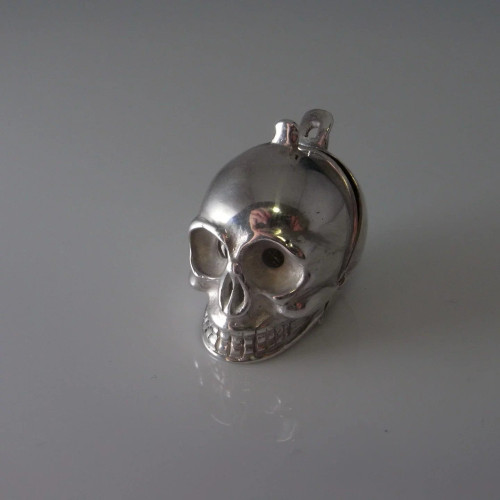An extremely rare museum quality 17th Century skull pomander memento mori pendant in fine silver dated 1679. It opens to reveal five compartments, four hidden behind a hinged lid. The lid inscribed with a religious quotation. A similar example is held by the British Museum.
With no public sanitation, no refrigeration, no regular bathing, no deodorants and open sewers... let's just say that life in the 1600s was richly pungent. Which brings us to pomanders...
Pomanders held strongly scented substances and were held to the nostrils to mask the smells of everyday life. In addition, it was widely believed that disease was spread by 'bad air', miasma. Combinations of scented ingredients were specifically formulated to protect the wearer against miasma in general and also specific illnesses, most famously the plague. The ingredients might include musk, ambergris, floral and herb extracts, spice oils,camphor and so on in a medium of resinous gums or waxes. It is also possible that a pomander like this held medicated snuff, powdered 'sniffing' tobacco, also employed for protection from infectious disease and plagues.
The word pomander is derived from the French term pomme d' ambre gris. Pomanders are seen in Europe from late middle ages and are described and illustrated in various 14th century documents and artworks. The simplest pomanders consisted of a ball of scented resins with an attached cord or lanyard. More elaborate forms featured a separate casing which held the scented ball. In modern usage, at least with respect to antiques, 'pomander' refers to these containers and not to their scented contents.
Pomanders were made from a variety of materials, including wood. Early examples were fashioned from strips of metal to form a cage enclosing the scented ball. Base metals were used but silver, gilt and gold were used for finer pieces. The metal was sometimes decoratively chased or engraved. Some were enamelled and very fine pieces were set with gems. With time, forms that completely enclosed the scented ball became more common. Pomanders were often worn suspended from a girdle, a belt or waist chain.
Pomanders were also worn in the fashion of a pendant. In the second half of the 16th century, pomanders like this one appeared with the interior divided to hold different solid perfumes, balms, snuffs or spices. By the late 18th century, liquid perfumes had replaced solids and the vinaigrette had replaced the pomander.
This skull pomander is an incredibly rare survivor from the period and opens to reveal 5 hidden compartments. The base is dated 1679, the year of the great plague of Vienna. Regions of Germany Holland and Bohemia were also affected. The great plague of London had only ended the previous year.
Inside an inscription reads 'Man proposes, but God disposes', a quotation from the famous medieval work 'The Imitation of Christ' by Thomas a Kempis. The inscription is in English which I think indicates that the pomander was either given or worn by an English speaker. It is likely of Continental manufacture. The full quotation is as follows: 'For the resolutions of the just depend rather on the grace of God than on their own wisdom; and in Him they always put their trust, whatever they take in hand. For man proposes, but God disposes; neither is the way of man in his own hands'.
Memento mori pieces from the period are sometimes inscribed with either a religious quotation or humorous verse. Memento Mori is latin for 'remember death', meaning individuals should not forget their own mortality and live their lives accordingly. To the religious it was a reminder to live a good and pious life so that one may enjoy the afterlife in heaven. To the hedonistic it was a reminder to live life to the fullest, eat drink and be merry for tomorrow we may die. The skull is a memento mori motif for both groups, we see the skull in church architecture but also on pirates' flags. Memento mori is an ancient philosophical concept and should not be confused with the much later cult of mourning and mourning jewelry.
This piece is an incredibly rare survivor from the period. Very few 1600s pomanders of any kind survive, even fewer in silver or gold. The few that do tend to be in the more common shapes such as vessels, gourds, various fruits. Memento mori skull pomanders like this one are beyond rare. The British Museum has just two, one in silver and another in gold. The Danish royal jewels includes another, that one gold and set with gems. Which gives one an idea of the collectability of this piece.
This pomander is in excellent condition and it is perfectly wearable. The catch was damaged when we found this antiquity and has been repaired to shut snugly. The bale, the loop for the chain, was also repaired at the same time. It weighs 17.2 grams and measures 1" tall by 1" deep by 13/16" wide (25 x 25 x 20mm).
A wonderful addition to any collection of antiquities or historical jewels. A superb gift for that special person. Whether you choose to simply display or to wear is up to you. The choice of secreted contents is also up to you - perfume, sweeteners, mints, medications. We cannot recommend poison no matter how authentic to period that may seem.
This special piece has been examined by a specialist antique jewelry appraiser and jewelry historian, included is the Certificate of Appraisal.
The photos form part of the description of this rare jewel.











